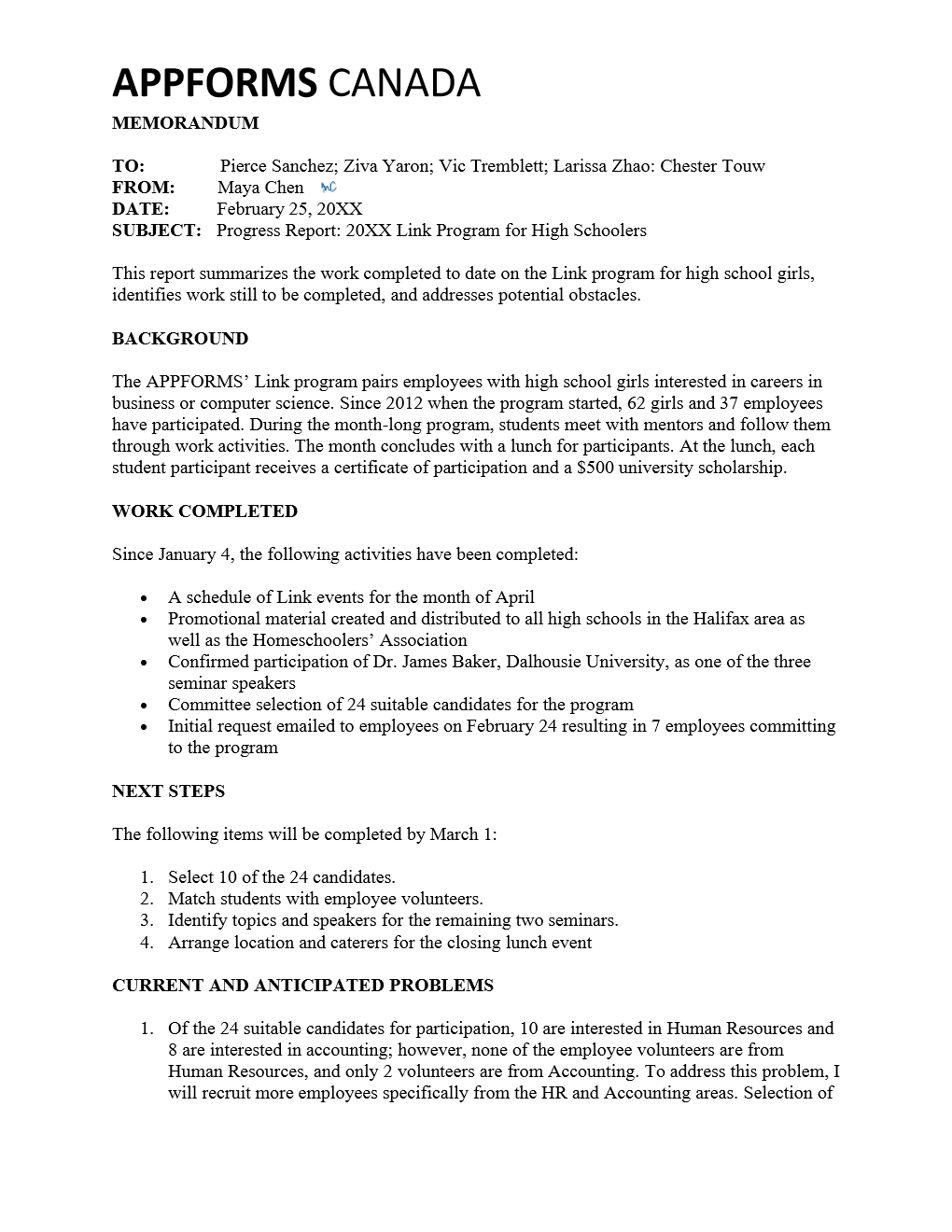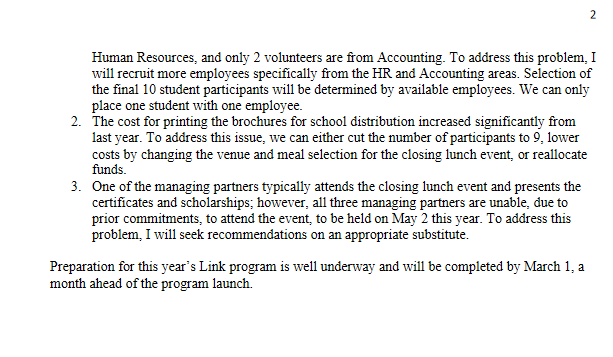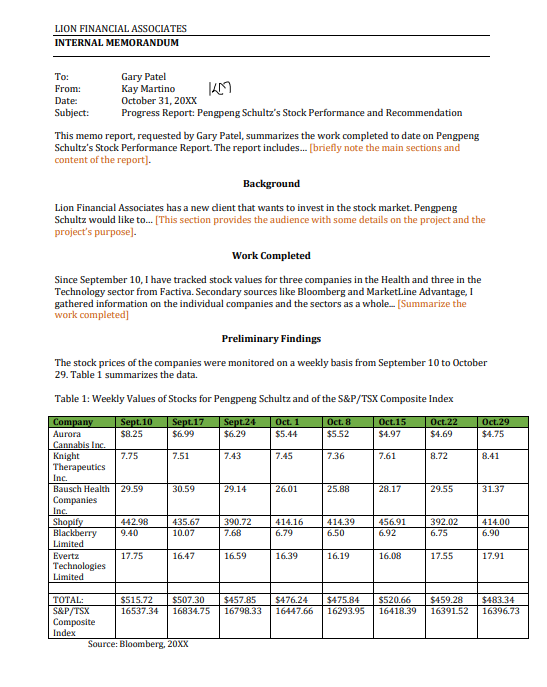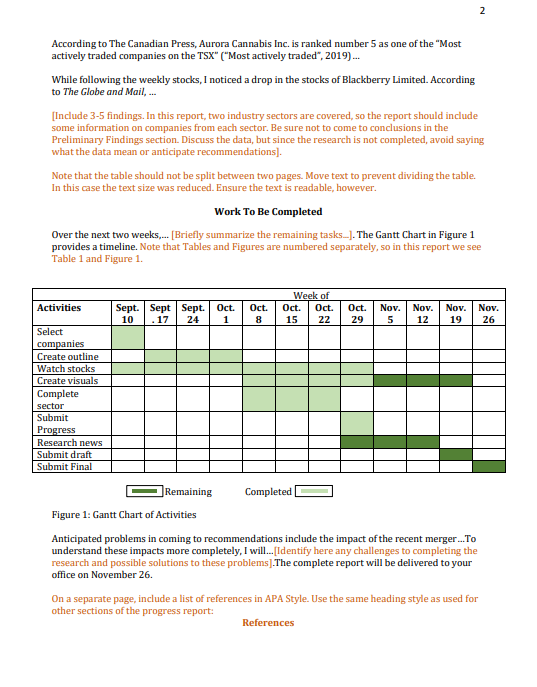4.5 Routine and Informational Messages: Memos and Short Informational Reports
This chapter is adapted from Lean, Ethical Business Communication (2017), by Binod Sundararajan and Linda Macdonald, published by Oxford University Press. Used with permission from the publisher.
Learning Objectives
- Identify the parts of a standard memo format
- Describe ways to enhance readability in the memo form
- Explain the organizational structure of a progress report
- Explain the purpose of a Gantt Chart
Memorandum, or “memos”, are documents internal to the organization. These memos typically outline procedure, announce policies, or relay information that may be shared to a wide internal audience. They often serve as an official record of policy or activity, and for this reason, they are often designed to be printed.
Each organization will have its own preferred style and use for memos.
Informational reports are direct; the main point is first, followed by the evidence to support it. So that information flows easily throughout the organization, informational reports begin with a clear statement of purpose.
The Case of Sean MacNeil: Informational Report
Sean has gathered information from Misha and investigated the top three transit apps in Halifax. Maru has asked Sean to bring copies of the report for distribution at the strategy meeting. He reminds Sean that the memo report should address content, cost, and customer feedback. He shows Sean where to access APPFORMS’ standard memo form and reminds him that Times New Roman font is the preferred print font for the company.
Sean does not know what exactly falls under the heading of “content” and doesn’t want to appear incompetent. Sean is also unsure of what their audience will do with the information, so Sean doesn’t know whether they should organize the report by discussing one app at a time or by category–content, cost, and feedback. Sean fears that they will appear lacking in knowledge or initiative, but decides that asking what is included under content and how their audience can best use the information is in their best interest and the interest of the Marketing team.
Maru is pleased that Sean has asked for clarification. Maru tells them that the company is seeking a niche in the marketplace and that typically the team looks at existing, related apps to determine their strengths and weaknesses and to identify the opportunity and threats APPFORMS would face in launching a new application. They are particularly interested in the interactive features of each app. They are also interested in customer feedback. The customer feedback, though often misleading, can reveal issues of usability and customer satisfaction.
Sean creates a document in keeping with the memo format as well as audience needs:
- Sean’s company uses a standard memo format with the company name at the top followed by “Memorandum.”
- To, from, date, and subject are provided and the information is aligned for readability.
- The subject line clearly indicates the purpose of the memo.
- Sean omits both a greeting and complimentary close and adds handwritten initials after his name.
- The first paragraph of the informational memo is brief yet includes all the necessary information– the purpose of the report, his projected organization, and a summary of his conclusions.
- Sean uses bolded headings and subheadings so the sections are easily identified.
- Maru has indicated that the team is especially interested in the interactive features, so these features are addressed first.
- Bulleted lists in the body of the report enhance readability.
- Memos are typically printed documents, so Sean uses a serif font for print readability.

___________________________________________________
The Case of Maya Chen: Work Progress Report
In addition to her work as a financial analyst, Maya Chen participates in APPFORMS’ corporate social responsibility (CSR) initiatives. Maya leads a program called Link that introduces senior high school girls to careers in business and computer science. Girls are partnered with APPFORMS employees in these fields for one month. During this time, the girls meet their mentors, “shadow” them at work, and participate in seminars. The month concludes with a lunch and presentation of certificates.
It is February, and Maya has already started preparing for the event, which begins in April. A meeting of area managers is scheduled for next week and Maya has been asked to submit a progress report to the group. She has already outlined the calendar of events, sent information flyers to local schools and a regional homeschoolers’ association, and selected, with a committee, a list of potential candidates. She has yet to match the girls with employees or to select the seminar topics and presenters.
The audience for the progress report includes managers who are familiar with the program. Link attracts the best and brightest students in the area and has a good reputation in the community and among the staff. Although the program is familiar to the managers, the criteria for selection, the logistical concerns, and the budget are less familiar to her audience. Because the progress report is aimed at managers, the report requires upward communication. Although the report is an internal document, Maya will need to maintain a level of formality appropriate for communication to people in higher level positions.
Maya considers the arrangement of her report. Because the program is one of many that involve students, Maya will begin with the purpose of the program and a brief overview. The body of the report will address work that has been completed and work that has yet to be done. The organization of the report follows its function; since the report reviews work in the past and addresses work for the future, a chronological pattern of organization is most logical. Maya also knows that the area managers will expect her to address any changes in expenses to date.
Maya produces a highly readable document:
- She uses a serif font appropriate for readability of printed documents.
- Bolded headings highlight key sections.
- White space around short paragraphs, lists, and headings enhances readability.
- Use of a standard memo format and chronological organizational pattern enable the reader to focus on content rather than form.
- The first paragraph concisely states the purpose and organizational strategy of the memo.

______________________________________________________________________
Progress reports vary in form and content but generally include background information, a summary of work completed, a summary of next steps, and and a list of anticipated problems and possible solutions. The date of completion for the project is confirmed in the conclusion. In addition, you may be asked to include a Gantt Chart for longer term projects (see Chapter 4.14). Gantt charts provide a timeline of work completed to date and work yet to be completed.
This student sample, a progress report on work completed to date on a recommendation report for a fictional client, is designed to demonstrate progress toward the final report. Excerpts of the progress report appear below with annotations appearing in brown type. The first paragraph tells the reader(s) who authorized the report and the purpose of the memo. The writer then provides a projected organization of the report. The document incorporates white space, headings, a table and a figure to enhance readability and provide ready access to information.

_____________________________________________________________________________

Check Your Knowledge

